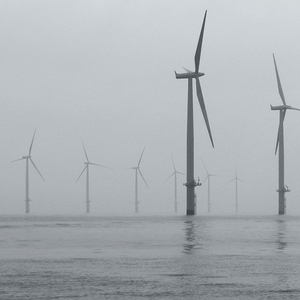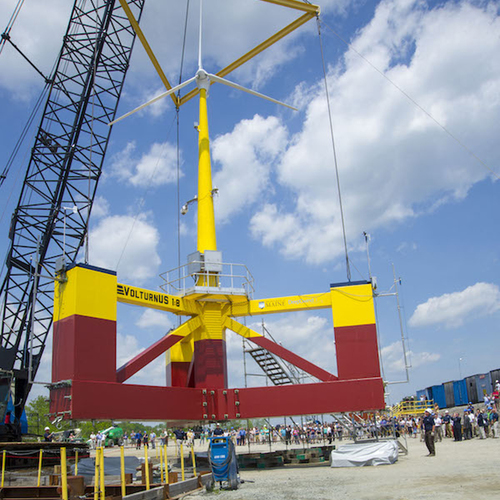
There are only five wind turbines operating in U.S. waters today. But that will likely soon change, partly because of states with ambitious offshore wind targets.
Off the Massachusetts coastline, for example, Vineyard Wind aims to build one of the nation’s first commercial-scale offshore wind farms. This planned 800-megawatt offshore wind farm will be capable of generating enough electricity to power at least 400,000 homes. And Rhode Island has given the company Deepwater Wind a green light to build a 400-megawatt offshore wind farm as well. These turbines, all of which are slated to be located near the island of Martha’s Vineyard, would be among several big offshore wind projects that could transform the grid.
We lead an offshore wind energy graduate program at the University of Massachusetts that brings together engineering, wildlife ecology, public engagement and political science students. Through this work, we have come to believe offshore will become a major new source of domestic renewable energy for the nation.
Momentum from the market and the states
The Massachusetts and Rhode Island ventures are planned to be built only a few miles away from the site that had been slated for Cape Wind, which was supposed to be the first commercial-scale offshore wind project ever built in the U.S. What changed after those plans collapsed in 2015 following a 13-year effort?
Perhaps the biggest momentum is coming from market forces, which have improved. Cape Wind’s troubles stemmed from a mix of high costs and public and political opposition that doomed the project. But the pace of nuclear and coal-fired plant closures has picked up since then.
Meanwhile, the cost of generating electricity through wind off the coast of Europe, the one region where the industry has gained critical mass, has decreased sharply.
Here in the U.S, the Trump administration is approving new leases for offshore wind development. And the industry is gaining state-level support, especially in an East Coast corridor that runs as far south as North Carolina.
Despite Cape Wind’s demise, Massachusetts became the first state to set offshore wind goals in 2016. It aims to install at least 1,600 megawatts of electricity — enough to power over 600,000 homes — by 2027.
Soon after, New York released an even more ambitious master plan, which aims to install 2,400 megawatts of electricity by 2030. Then, New Jersey went further, committing to a 3,500-megawatt goal by 2030.
Besides these three states, another five — Maryland, Virginia, Rhode Island, North Carolina and Delaware — are also moving forward, with federally approved leases to develop offshore windfarms. One in 5 Americans lives in these eight states. The 600,000 jobs the Energy Department predicts that onshore and offshore wind energy will create by 2050 help explain their interest.
Meanwhile, things are moving forward in other states as well. Hawaii plans to rely heavily on offshore wind as part of its goal of getting all its power from renewable sources by 2045. Like states on the West Coast, Hawaii has not gotten federal approval yet for any leases.
An energy gap
When you flip a switch, you expect the lights to turn on. Yet few Americans are aware of the delicate balance between supply and demand that makes it possible for the nation’s lights, appliances and factories to keep humming.
Grid operators ensure different sources of generation, primarily coal, natural gas, nuclear, and renewable energy like wind, hydropower, and solar, meet demand. This mix varies by region, time of day and season, and the balance between these different electricity sources has changed significantly in the past two decades.
The biggest transformations are the rising share of power derived from natural gas and wind and the decline in coal. As recently as 2000, coal produced more than half of the nation’s electricity, while natural gas contributed only 13%, and a combination of wind, solar, and geothermal energy powered less than 1% percent of the grid. By 2017, the share of coal-fired power had fallen to 30% and natural gas had jumped to 32%. The share of electricity from renewable sources aside from hydropower — primarily wind — had hit 8% and was growing rapidly.
The share of nuclear power has remained steady at about 20% of the national grid, but that will change as many old nuclear reactors are decommissioned.
In New England, for example, the Pilgrim nuclear power plant in Plymouth, Massachusetts, will shut down in 2019. Four nuclear plants serving customers in Ohio and Pennsylvania are now scheduled to close as well.
Meanwhile, the Brayton Point coal plant, the last in New England, also stopped operating in 2017. All told, utilities and state power authorities are retiring about 16% percent of the region’s generating capacity between 2013 and 2021, including coal-fired plant and nuclear reactor closures.
With all the coal and nuclear closures across the country, experts anticipate that the U.S. will need approximately 3 terawatt hours of new capacity by 2050. This projection, which is based on historical trends at a time when the grid is being transformed, is a massive amount of electricity, equal to about three-fourths of all the power Americans consumed in 2017. Filling that gap may be daunting, but it also creates a chance to upgrade the nation’s power infrastructure while helping to tackle climate change.
Lower offshore wind prices
Even with an impending burst of demand for new power sources, the offshore wind industry would not be nearly as promising if not for the plunging prices seen in Europe, where the industry has already taken off.
In 2010, electricity generated through offshore wind off the European coastline cost around 17 cents per kilowatt hour, more than twice what utilities were paying for power derived from burning gas and coal. The price fell to around 13 cents by 2017. But when Germany and the Netherlands recently awarded some of the first unsubsidized offshore wind contracts, bids had fallen to as little as 6 cents.
What’s driving this decline? A number of factors. Wind turbine blades keep getting longer, doubling in length since 2000. These blades are now nearly as long as football fields – about 270 feet – on 8-megawatt turbines. The extra length means they capture more power, generating more revenue from every turbine.
In addition, offshore wind turbines have grown more reliable, and government subsidies and mandates have incubated and sped the development of Europe’s industry. While electricity from U.S. offshore wind farms will initially cost system operators more in the U.S. than in Europe — as is common with any breakthrough projects — we predict that prices will fall once the market gets bigger here.
The Energy Department projects that there will be a total 86 gigawatts of U.S. installed offshore wind capacity by 2050, about 7% of the capacity of today’s grid and only 4% of the vast potential to harness this kind of energy. Given the speed with which prices are falling in Europe, we believe that offshore wind could ultimately play an even bigger role than that, especially should the federal government again make fighting climate change a top priority.
Matthew Lackner is associate professor of mechanical engineering at the University of Massachusetts Amherst. Erin Baker is professor of industrial engineering at the University of Massachusetts Amherst. This article is republished from The Conversation under a Creative Commons license. Read the original article.
Weekly Newsletter
Get building science and energy efficiency advice, plus special offers, in your inbox.















4 Comments
I totally see that wind, solar and natural gas plants are going to be key additions to U.S. electrical generation in the coming years. But 'offshore-wind' has been 'about to take off' for such a long time that i think you should be a bit more cautious. More recent Department of Energy forecasts from the EIA show very limited offshore wind development recently. When I follow the link to the Department of Energy report you cite, it takes me to a report dated March 12, 2015: https://www.energy.gov/sites/prod/files/WindVision_Report_final.pdf
More recent forecasts of 2019 additions (Dated Jan 10, 2019) show that wind will be 46% of new generating capacity (with Natural gas being 34% and solar being 18%), but nearly all of that is from on-shore wind: https://www.eia.gov/todayinenergy/detail.php?id=37952#
Getting longer term forecasts is tough, but this report from Aug 2018 doesn't show all that favorable costs for onshore wind (and offshore would be even higher). Basically solar is still dropping quickly, natural gas is relatively flat but cheap, while onshore wind is between solar and natural gas, but not really dropping much in cost recently: https://www.eia.gov/todayinenergy/detail.php?id=36813
The EIA is one of the LEAST reliable resources for projecting even last year's costs of renewables, let alone future cost trends. (Or perhaps they are the most reliable, consistently overestimating costs an underestimating deployment by double and sometimes triple digit percentages, whereas some other sources get it down to a single digit percentage error sometimes.)
The EIA aren't the only ones with permanent egg on their faces- contract price bids for the initial tranche of offshore wind in MA came in lower than even third-tranche projections based on better analysis than anything the EIA has ever published.
Unfortunately utility managers, grid operators, and elected policy makers have a habit of looking at the EIA and IEA numbers for guidance & planning.
Jonathan,
For more information on EIA's disastrous track record, see these articles:
"Government Estimates on Renewables Are Way Off"
"Will Faulty Energy Projections Become Reality?"
Piling on to the obvious (and less obvious )shortcomings of the EIA analysis comes this bit from GTM today:
https://www.greentechmedia.com/articles/read/eia-outlook-conservative-renewables#gs.pXP6t4Vt
Log in or create an account to post a comment.
Sign up Log in